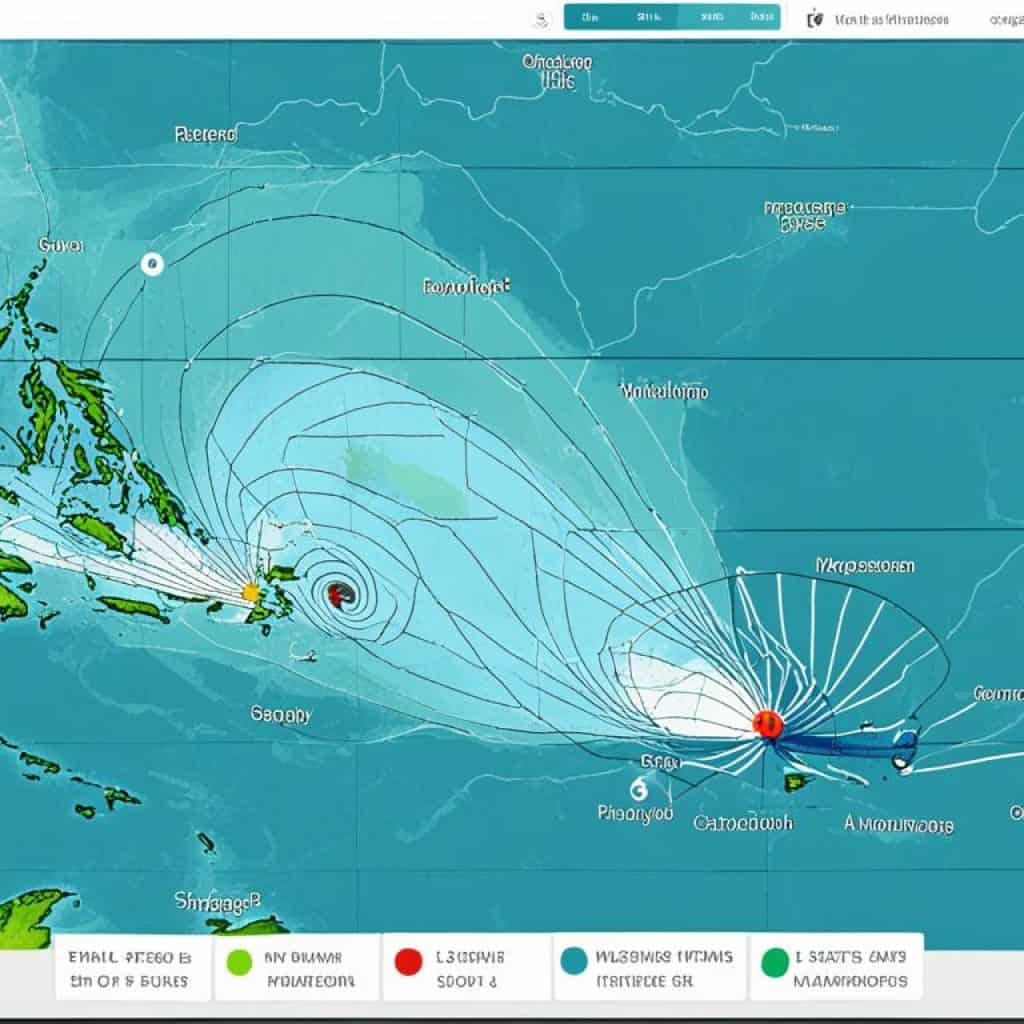Weather patterns in the Philippines can bring about powerful storms that can have serious consequences. From tropical storms to typhoons, it is crucial to stay updated on the current storm status to ensure safety and preparedness. Are you aware of the latest storm updates in the Philippines? Let’s dive in and explore the current situation to understand how to navigate through these unpredictable weather conditions.
From typhoon alerts to weather forecasts, we’ll provide you with the information you need to stay informed about the current typhoon situation in the Philippines. Discover how storm tracking and tropical storm alerts can help you make informed decisions and take necessary safety measures.
Key Takeaways:
- Stay updated on the current storm status in the Philippines to ensure safety and preparedness.
- Use typhoon alerts, weather forecasts, and storm tracking to stay informed about the latest storm updates.
- Take necessary safety measures to mitigate the risks associated with storms in the Philippines.
- Understand the significance of tropical storm alerts and how they contribute to public safety.
- Contribute to public safety by being aware of hurricane evacuation zones and receiving warnings about potential disasters like flooding.
Understanding Tropical Storms
Tropical storms are natural disasters that occur due to areas of extremely low pressure on the earth’s surface. These storms have the potential to develop into hurricanes, which can cause significant damage and pose a threat to lives and properties.
A tropical storm is considered a hurricane when its wind speed exceeds 73 mph. As the wind speed increases, so does the intensity of the storm. Understanding the different categories of hurricanes and their corresponding wind speeds is crucial for assessing the severity of a storm and implementing appropriate safety measures.
Here is a breakdown of the hurricane categories and their corresponding wind speeds:
| Hurricane Category | Wind Speed (mph) |
|---|---|
| Category 1 | 74-95 |
| Category 2 | 96-110 |
| Category 3 | 111-129 |
| Category 4 | 130-156 |
| Category 5 | 157 or higher |
Knowing the category of a hurricane helps authorities and individuals in making informed decisions and taking necessary precautions to ensure personal safety and safeguard valuable assets.
Remember, tropical storms and hurricanes are powerful forces of nature. Stay informed, follow evacuation orders, and prioritize your safety.
Tracking Hurricanes and Tropical Storms
Tracking hurricanes and tropical storms is essential for predicting their movement and potential impact. By utilizing a live hurricane radar map, individuals can stay informed about the past, current, and predicted path of a storm. The map presents colorful dots that depict the storm’s movement, with each color representing a different type of tropical storm. This dynamic tracking information enables a better understanding of the storm’s trajectory and potential hazards.
To track hurricanes and tropical storms effectively, utilize the following features of a hurricane radar map:
- Live updates: Stay up-to-date with real-time storm movement.
- Past path: Review the historical track of the storm to gain insights into its behavior.
- Predicted path: Anticipate the storm’s future direction based on projections.
- Storm colors: Differentiate between various types of tropical storms through color-coded markers.
Understanding storm movement and projected paths empowers individuals to make informed decisions regarding safety measures, evacuation routes, and other necessary precautions. By utilizing a comprehensive hurricane radar map, tracking hurricanes and tropical storms becomes more accessible and efficient, providing crucial information to protect lives and property.
| Storm Category | Wind Speed (mph) | Description |
|---|---|---|
| Category 1 | 74-95 | Minimal damage with some power outages and damage to vegetation. |
| Category 2 | 96-110 | Moderate damage with power outages, structural damage, and minor flooding. |
| Category 3 | 111-129 | Extensive damage with power outages, significant structural damage, and flooding. |
| Category 4 | 130-156 | Severe damage with extended power outages, catastrophic structural damage, and widespread flooding. |
| Category 5 | 157+ | Devastating damage with prolonged power outages, catastrophic structural damage, and extensive flooding. |
It is crucial to monitor storm movement, past paths, predicted paths, and storm colors to stay prepared and ensure the safety of oneself and others. Keeping a watchful eye on hurricanes and tropical storms through reliable tracker tools guarantees timely response and informed decision-making.
Current Storms in the Philippines
While there are no active hurricanes or tropical cyclones in the Philippines at the moment, it is crucial to remain vigilant and stay informed about potential storms. Monitoring factors such as wind speed, storm movement, and hurricane category can provide valuable insights for preparedness and safety measures.
By regularly checking updates and forecasts, individuals can ensure they are well-prepared in case of any sudden changes in weather conditions. Being aware of the latest hurricane information can help in making informed decisions and taking necessary precautions to safeguard lives and property.
Remember, even though there are no active storms in the Philippines currently, it is important to stay updated and prepared. Keep an eye on official weather sources and heed any warnings or advisories issued by the relevant authorities. Your safety and well-being is paramount.
Features of Storm Tracking Apps
When it comes to monitoring storms and staying informed about their location and intensity, storm tracking apps are an invaluable tool. These apps offer a range of features that provide users with essential storm information and timely alerts, ensuring their safety and preparedness.
One of the key features of these apps is the ability to provide extended information on storms. Users can access details such as the storm’s category, wind speed, and movement speed. This information allows for a better understanding of the storm’s potential impact and the necessary precautions to take.
Push notifications are another essential feature of storm tracking apps. These notifications alert users when a hurricane or tropical storm is near their location. This timely information enables individuals to evacuate promptly and seek assistance if needed. Whether you’re at home or on the go, push notifications keep you updated and safe.
Another valuable feature is the ability to track storms on a map. Storm tracking apps offer interactive maps that allow users to visualize storm tracks, both past and predicted. Users can toggle storm tracks on and off, making it easier to follow the storm’s trajectory and understand its potential hazards.
Furthermore, storm tracking apps provide access to satellite data and radar coverage. These additional layers of information offer a comprehensive view of the storm, enhancing the user’s understanding and situational awareness. With satellite data and radar coverage, users can gain insights into the storm’s size, structure, and potential intensification.
Here is an example of how storm tracking apps can provide a comprehensive view of a storm:
| Feature | Description |
|---|---|
| Storm Information | Provides extended details on storm category, wind speed, and movement speed. |
| Push Notifications | Alerts users when a hurricane or tropical storm is near their location. |
| Storm Tracks | Allows users to visualize and toggle storm tracks on interactive maps. |
| Satellite Data | Offers access to satellite imagery for a comprehensive view of the storm. |
| Radar Coverage | Provides real-time radar coverage to track the storm’s movement. |
With these features, storm tracking apps empower individuals to make informed decisions, ensuring their safety and the safety of those around them. By utilizing the latest technology and data, these apps contribute to better storm monitoring and preparedness.
Stay on top of storm updates and keep yourself and your loved ones safe with a reliable hurricane radar app.

Weather Conditions and Forecasts
When it comes to predicting and understanding storms, monitoring weather conditions is crucial. By keeping an eye on various factors such as temperature, cloud cover, rain chance, barometric pressure, and UV level, we can gain valuable insights into the likelihood and intensity of a storm forming.
Temperature plays a significant role in determining the atmospheric conditions that favor storm development. Higher temperatures create an environment conducive to convection, which is essential for storm formation. Monitoring temperature changes can give us a better understanding of the potential for storms in a particular area.
Cloud cover is another important indicator. Increased cloud cover indicates the presence of moisture and instability in the atmosphere, which can contribute to storm development. Observing changes in cloud cover over time can provide valuable insights into evolving weather patterns.
Rain chance is a key factor to consider when assessing storm potential. By monitoring the probability of rainfall in a given area, we can better anticipate storm activity. This information is particularly useful for planning outdoor activities and taking necessary precautions.
Barometric pressure is a measure of the weight of the atmosphere above a specific location. Low barometric pressure is often associated with stormy weather conditions, as it indicates the presence of unsettled air. Monitoring changes in barometric pressure can help us anticipate storms and prepare accordingly.
The UV level is an important consideration for both safety and comfort. High UV levels can pose health risks, such as sunburn and skin damage. Tracking the UV index allows us to take appropriate measures, such as applying sunscreen and seeking shade, to protect ourselves from excessive UV exposure.
Staying updated on accurate weather forecasts is crucial for making informed decisions regarding storm preparedness. By relying on reliable sources for weather information, we can plan our activities, ensure safety measures are in place, and minimize the risks associated with severe weather events.
Keep an eye on the evolving weather conditions, and be prepared for whatever Mother Nature has in store. Now, let’s take a closer look at the astronomical twilight and sky illumination in the next section.
Astronomical Twilight and Sky Illumination
When it comes to planning outdoor activities and assessing visibility conditions, understanding astronomical twilight and sky illumination plays a crucial role. Astronomical twilight refers to the period when the sun is between 12 and 18 degrees below the horizon, resulting in limited natural light. During this time, the sun does not contribute to the illumination of the sky, creating a unique ambiance for stargazing and observing celestial phenomena.
One of the key factors influenced by astronomical twilight is the visibility of the horizon. As the sun sinks below the horizon during sunset and rises during sunrise, the gradual transition from daylight to astronomical twilight affects the clarity and visibility of distant objects, such as mountains or bodies of water.
During this time, the sky takes on a distinctive hue, characterized by a deep blue or violet shade, depending on atmospheric conditions. This ethereal color palette provides a captivating backdrop for photographers and nature enthusiasts, enhancing the beauty of landscapes.
“The allure of astronomical twilight lies in the delicate balance between diminishing daylight and the emergence of a mystical nocturnal realm.” – Astronomical Enthusiast
Additionally, astronomical twilight is of great importance to astronomers and stargazers, as it marks the moment when they can begin their observations free from the interference of sunlight. With the darkening sky, celestial objects like stars, planets, and galaxies become more visible, revealing the awe-inspiring beauty of the cosmos.
To illuminate the concept of astronomical twilight and its impact on the sky, let’s take a look at the table below, which highlights the key phases related to sunrise and sunset:
| Sun Phase | Position | Sky Illumination |
|---|---|---|
| Sunrise | Below the horizon | Low |
| Astronomical Twilight Begins | Sun 18 degrees below the horizon | Minimal |
| Astronomical Twilight Ends | Sun 12 degrees below the horizon | Negligible |
| Sunset | Below the horizon | Low |
As depicted in the table, the transition from astronomical twilight to complete darkness occurs gradually, allowing for different levels of sky illumination depending on the position of the sun relative to the horizon. This natural phenomenon offers a unique opportunity to witness the serene beauty of dawn or dusk and appreciate the profound connection between the earth, sun, and sky.
Now that we have explored the concept of astronomical twilight and its impact on the sky, let’s delve deeper into the duration of daylight and twilight in the following section.
Duration of Daylight and Twilight
The duration of daylight and twilight varies depending on the time of year. Monitoring the times of actual sunrise and sunset is crucial for understanding the length of daylight. Additionally, it is important to note the change in daylight duration between consecutive days. During civil sunrise and civil sunset, the sun is between 6 and 12 degrees below the horizon. Let’s explore these factors further.
Actual Sunrise and Sunset
Tracking the actual sunrise and sunset times provides valuable information about the length of daylight. By observing the exact moments when the sun appears and disappears on the horizon, we can plan our activities accordingly. The table below presents the actual sunrise and sunset times for different months in a given location.
| Month | Actual Sunrise | Actual Sunset |
|---|---|---|
| January | 6:30 AM | 5:45 PM |
| February | 6:15 AM | 6:00 PM |
| March | 6:00 AM | 6:15 PM |
| April | 5:45 AM | 6:30 PM |
Change in Daylight Duration
The change in daylight duration from one day to another can have a significant impact on our daily routines. By monitoring the increase or decrease in daylight, we can adapt our schedules and activities accordingly. The table below showcases the change in daylight duration between consecutive days for a specific location.
| Date | Daylight Duration Change |
|---|---|
| March 20 | +2 minutes |
| March 21 | +3 minutes |
| March 22 | +4 minutes |
| March 23 | +4 minutes |
“The beauty of the sunset can’t be measured by the length of daylight but by the brilliance of the colors it paints in the sky.”
Understanding the duration of daylight and twilight is essential for planning outdoor activities, capturing picturesque moments, and appreciating the marvels of nature. By staying mindful of the actual sunrise and sunset times and the change in daylight duration, we can make the most of each day.

Weather Forecast for the Philippines
The weather forecast for the Philippines indicates a mix of scattered showers, mostly sunny conditions, and partly cloudy skies. It is important to stay prepared for sudden changes in weather and monitor the chance of rainfall. Regularly checking the weather forecast helps in planning outdoor activities and ensuring safety.
Video: Tips for Outdoor Activities in Changing Weather
With changing weather conditions, it is important to take appropriate measures for outdoor activities. This video provides useful tips and safety measures to follow, ensuring a pleasant and secure experience. From preparing for changing weather to staying hydrated, these tips help in making the most out of outdoor activities.
| Tips for Outdoor Activities in Changing Weather | Description |
|---|---|
| 1. Check the weather forecast | Stay prepared by checking the weather forecast before heading out. Be aware of any potential storms or sudden changes in weather conditions. |
| 2. Dress appropriately | Wear layers that can be easily added or removed to adjust to changing temperatures. Don’t forget to wear appropriate footwear for the terrain. |
| 3. Stay hydrated | Bring enough water to stay hydrated throughout your outdoor activities. Consider bringing electrolyte drinks for longer outings. |
| 4. Protect yourself from the sun | Apply sunscreen, wear a hat, and use sunglasses to protect yourself from harmful UV rays. Seek shade during peak sun hours. |
| 5. Be prepared for rain | Carry a waterproof jacket or poncho in case of unexpected rain showers. Keep your belongings protected in waterproof bags. |
| 6. Check trail conditions | If hiking or walking on trails, check for any trail closures or hazardous conditions caused by changing weather. |
| 7. Bring appropriate gear | Depending on the activity, pack gear such as compasses, maps, GPS devices, and first aid kits. Safety should always be a priority. |
| 8. Monitor changing weather conditions | Keep an eye on the sky and be aware of any signs of changing weather conditions. Be prepared to modify or cancel your plans if necessary. |
Remember, outdoor activities can be enjoyable and rewarding, but it’s vital to prioritize safety and be prepared for changing weather conditions. Stay up-to-date with weather forecasts, follow these tips, and have a great time exploring the outdoors!

Conclusion
Staying updated on the current storm status in the Philippines is of utmost importance when it comes to ensuring the safety and preparedness of individuals and communities. By regularly checking weather forecasts, tracking storms, and monitoring various indicators, such as wind speed and movement, we can take proactive safety measures to mitigate the risks associated with storms.
Following the provided guidelines and staying informed about the current storm status enables us to navigate through changing weather conditions effectively. By being aware of the potential hazards and preparing accordingly, we can protect ourselves and others from harm.
Remember, it is essential to prioritize safety during stormy weather. Keep an eye on the weather forecasts, stay updated on storm tracking data, and follow the recommended safety measures. By doing so, we can minimize the impact of storms and prioritize the well-being of everyone in the Philippines.


















Add comment